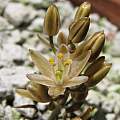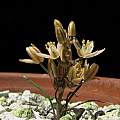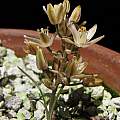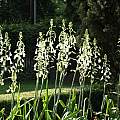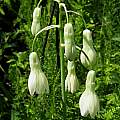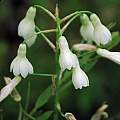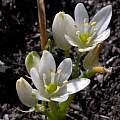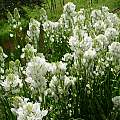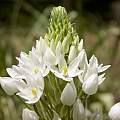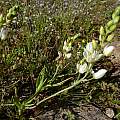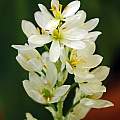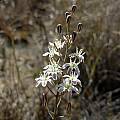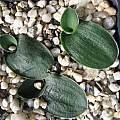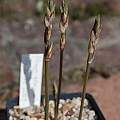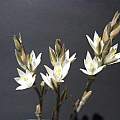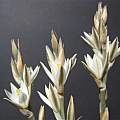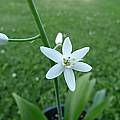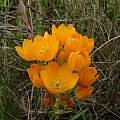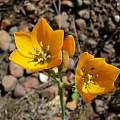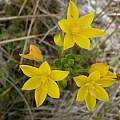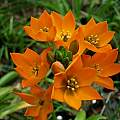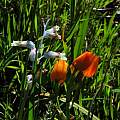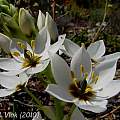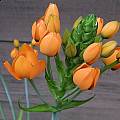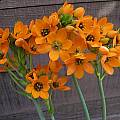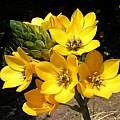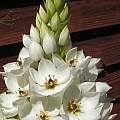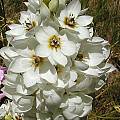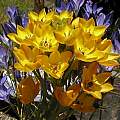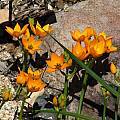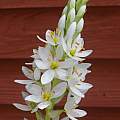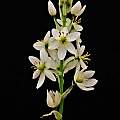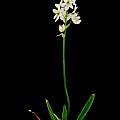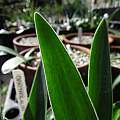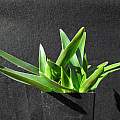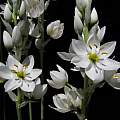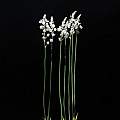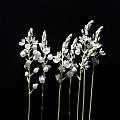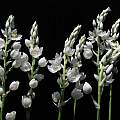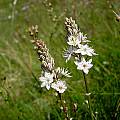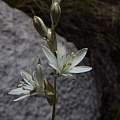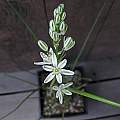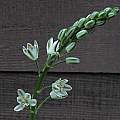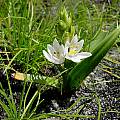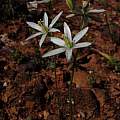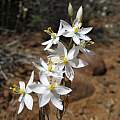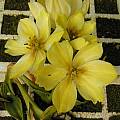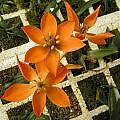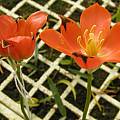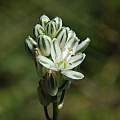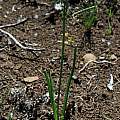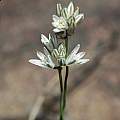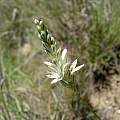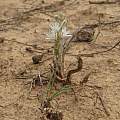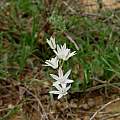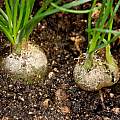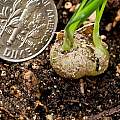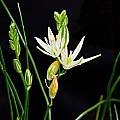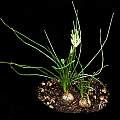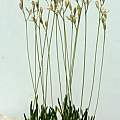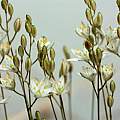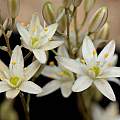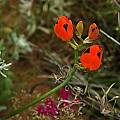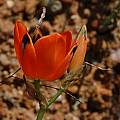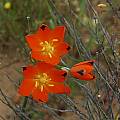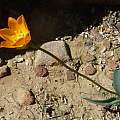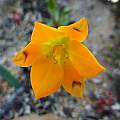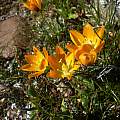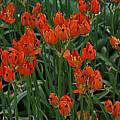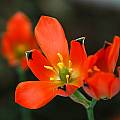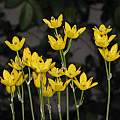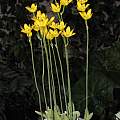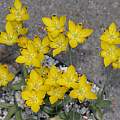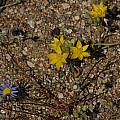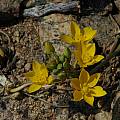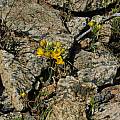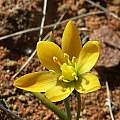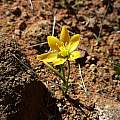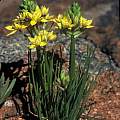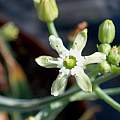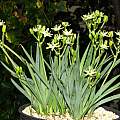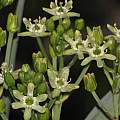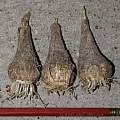On this wiki page we will list the Ornithogalum species that originate in southern Africa from a-o.
Ornithogalum index - Southern African Ornithogalums from p-z
Ornithogalum adseptentrionesvergentulum U.Müll.-Doblies & D.Müll.-Doblies is one of the world's most miniature bulb species (under 3 cm tall) and yet it has one of the longest names of any plant in the world. It is native to an area north of Laingsburg in the western end of the Great Karoo Desert of South Africa. The climate is harsh there with hot days and freezing nights with an average of 150 mm precipitation per year, falling only in winter. It is a winter-growing species, dormant in the summer. In some years when there hasn't been enough rain the bulbs will skip growing seasons and remain dormant, conserving their energy for better years. To avoid deep frosts they inhabit hillsides that are covered in grey shale that get shade in the summer from the intense force of direct desert sunlight. In habitat the leaves all lean to the north, hence its sesquipedalian specific epithet, and blend in with the grey shale that surrounds them. In the experience of Nhu Nguyen and Uluwehi Knecht growing this species in Berkeley, California, its leaves haven't demonstrated quite so much determination to lean in a single direction. It produces impressive numbers of charming blush-cream flowers with a quite reflective, sparkly appearance that open sequentially. The four photos below show a plant grown by Nhu Nguyen and Uluwehi Knecht, photographed by Uluwehi Knecht.
Ornithogalum candicans (Baker) J.C.Manning & Goldblatt is the new name for Galtonia candicans. This gracious species' native range covers the East Cape Province of South Africa and also includes Lesotho. Height range: 100-120 cm. The first picture shows a planting grown and photographed by Uluwehi Knecht. The second was taken at Satansnek Pass in the Eastern Cape of South Africa by Cameron McMaster. The last photo from Mary Sue Ittner was taken at the same spot.
Ornithogalum caudatum Aiton see Albuca bracteata
Ornithogalum comptonii Leight. is found on shale ridges in the lowlands or moist sandy soils on rocky outcrops on mountain crests in the western and Little Karoo. It has narrow channelled leaves with hairy margins and white flowers with brown keels. Height: 5-10 cm. Flowering can occur from October to July. Photo from the book Plants of the Klein Karoo courtesy of Jan and Anne Lise Schutte-Vlok.
Ornithogalum concordianum (Baker) U.Müll.-Doblies & D.Müll.-Doblies see Albuca concordiana
Ornithogalum conicum Jacq. is found in clay or loam flats over a wide area from the Bokkeveld Plateau and western Karoo to the Cape Peninsula and the Eastern Cape. Growing from 40 to 100 cm high, it has lanceolate leaves that are green or dry at flowering and white flowers in a conical or cylindrical raceme. The first three photos were taken by Cameron McMaster. The first was taken in the Eastern Cape and the third in Namaqualand.? The last photo was taken by Mary Sue Ittner in the Kirstenbosch National Botanical Garden bulb room.
Ornithogalum constrictum F.M. Leight is a widespread species from both the winter rainfall, year round rainfall, and summer rainfall areas of the Western and Eastern Cape with a strange outpost in the Northern Cape. It has been found in Bredasdorp, Grahamstown, Hondeklipbaai. It has white flowers with greenish keels below and one to three prostrate, oblong leaves, dry at flowering. Height: 20-40 cm. It flowers November to February in the wild. The first photo below by Cameron McMaster was taken in the Overberg of a plant found in clay soils in the renosterveld. The rest of the photos were taken by Hans Joschko of a plant in cultivation. This plant seems to make a lot of seeds and can spread itself in a collection.
Ornithogalum convallarioides H.Perrier, syn. Avonsera convallarioides (H.Perrier) Speta, is from Madagascar. A seller on Ebay suggests keeping it moist in summer and dry in winter and states it is an excellent houseplant candidate that flowers late spring or summer. Height range: up to 50 cm. Photos by Alessandro Marinello.
Ornithogalum dubium Houtt. is a long blooming plant with beautiful large flowers, yellow to orange or rarely white, often with a green or brown center. Growing from 10 to 50 cm, this species has leaves that are linear to ovate with minutely hairy margins. It is found on mountains and flats over a broad area in the Cape Province of South Africa. Flowering time can be late winter until early spring. Photos below were taken by Cameron McMaster in the Overberg.
The first two photos were taken by Mary Sue Ittner of plants found flowering near Tulbagh August 2006. One of them is pictured with Lachenalia unifolia. The last photo is from the book Plants of the Klein Karoo courtesy of Jan and Anne Lise Schutte-Vlok.
Some of us have found it difficult to get bulbs to come up and flower every year. Often only one or two of four bulbs appear. The bulbs still look healthy if you dump them out, but they don't always choose to grow. One year one sent up 9 flowering stalks whereas usually there is only one. It is reported by some growers that this species benefits from a little bit of water during the summer dormancy. However, summer watering should always be made with care and success depends on the individual's summer climate. Another speculated that a warm period during dormancy was necessary. First two photos by Mary Sue Ittner of flowers in bud and opening. Most years it is possible to buy ornithogalums at garden centers that probably are Ornithogalum dubium or have it in their heritage. One year I bought three that were just labeled white, yellow, and orange. They all bloomed for a long time. None of them chose to grow the following year however. This yellow one was blooming at the same time as Triteleia laxa and Triteleia peduncularis pictured in the background and I found that a pleasing color combination. The first five photos from Mary Sue Ittner. The last photo from Bob Rutemoeller.
The photo below was taken by Nhu Nguyen at the UC Botanical Garden where a nice clump flowers every year.
Ornithogalum fimbrimarginatum F.M.Leight. is distributed from the Gifberg to the Eastern Cape. Growing from 20 to 45 cm with about five leaves, usually dry at flowering, it has white lightly-scented flowers with or without a dark center. Its botanical name reflects the hairy leaf margins. The first photograph was taken by Mary Sue Ittner. The next two photographs were taken by Ed Mertz of plants belonging to Pamela Slate, contributed by Pamela Slate. These plants originate from bulbs donated to BX 247 by Roy Herold.
The photos below were taken by Nhu Nguyen showing the leaf margin that gives this species its name and the flowers.
Ornithogalum graminifolium Thunb. is found on stony clay flats and slopes, often in moist sites from the western Karoo to KwaZulu-Natal. Known as grass chink, it has linear to lanceolate leaves and white, yellow or pink flowers. Height: 10-40 cm. This species has a wide distribution and is very variable in color and habit. It blooms in summer. The first photo was taken by Cameron McMaster. The second photo from the book Plants of the Klein Karoo is courtesy of Jan and Anne Lise Schutte-Vlok. The last two photos were taken by Mary Sue Ittner of plants grown from IBSA seed.
Ornithogalum hispidum Hornem. is found on clay flats and stony clay slopes from Namaqualand to Worcester. Growing from 10 to 40 cm, this species flowers from August to October. Leaves are distinctive, three to six, often with spotted sheathing bases and hairy, green or dry at flowering. Flowers are white in a narrow raceme. The first photo by Cameron McMaster taken in the Overberg. The second photo from the book Plants of the Klein Karoo courtesy of Jan and Anne Lise Schutte-Vlok. The last photo from Rod Saunders.
Ornithogalum hybrids Rod Saunders and Rachel Saunders of Silverhill Seeds with their partner, Andy, were creating hybrids from some of the South African species. Here are pictures of three of them photographed by Bob Rutemoeller
Ornithogalum juncifolium Jacq., syn. Nicipe juncifolium, is found in damp, grassy areas, on cliffs, up to 2300 m from the southeastern Cape to Mpumalanga. It has narrow ribbed leaves and white flowers with central green stripes. Height range: 10-40 cm. The first three photos from Mary Sue Ittner were taken January 2010 at Gaika's Kop. The last three photos were taken by Cameron McMaster in the Eastern Cape.
Photos below from Pamela Slate who wondered what species this was. Close-ups of the bulbs show the basal leaf clasping that becomes terete halfway or more toward the leaf tip. Flowers are 1.5 cm in diameter, slightly smaller than the bulbs in these photos. The entire plant is only 4-5 inches tall.
Ornithogalum lithopsoides van Jaarsv. is native to the Western Cape of South Africa. There is more information about it here. Height range: 20-30 cm. The photos below were taken by Jeff from Bulbesetpots.com.
Ornithogalum longibracteatum Jacq. see Albuca bracteata
Ornithogalum maculatum Jacq. is found in sandy soils, often in rocks from Namaqualand to the southwest Cape and the western Karoo. It is a very striking plant with orange to orange-red or yellow flowers with the outer tepal tips often having a dark blotch. Height range: 8-50 cm tall. These first 3 photos were taken September 2006 in Namaqualand by Bob Rutemoeller and Mary Sue Ittner. Flowers seen in the morning mist were not yet open, but later in the day they were. Photos 4-6 were taken on the Biekoes Farm near Nieuwoudtville by Cameron McMaster September 2011.
Photos below from Bob Rutemoeller and Mary Sue Ittner are of plants being produced by tissue culture by Andy Hackland in partnership with Silverhill Seeds.
Photos by Dylan Hannon collected by John Lavranos in the Kamiesberg.
Ornithogalum multifolium Baker is a tiny plant usually less than 10 cm high, but can be up to 25 cm. It is found in shallow pockets of soil on rock outcrops from Namaqualand south to areas in the Western Cape. We saw it often with the flowers closed in the early morning or later in the day in the Roggeveld and the Bokkeveld Plateau in September 2006. The first three photos were taken by Bob Rutemoeller and Mary Sue Ittner of a group seen in Namaqualand in the middle of the day and illustrate the habitat as well as the flowers. The fourth and fifth photos were taken September 2011 by Cameron McMaster in the Roggeveld. The last photo was taken by Rod Saunders.
Ornithogalum neopatersonia J.C.Manning & Goldblatt, syn. Neopatersonia uitenhagensis Schönland, grows on mostly limestone slopes and has greenish flowers with white stamens. Height: 15-20 cm high. It blooms in the spring. Photo 1 was taken by Alan Horstmann. The second was an unidentified species likely to be this species photographed by Digby Boswell. The rest of the photographs were taken by Dylan Hannon.
Ornithogalum osmynellum U.Müll.-Doblies & D.Müll.-Doblies see Albuca osmynella
Related genera are listed below. Some of these are now included in Ornithogalum or were recently included and now restored to genus status:
Albuca - Dipcadi - Galtonia - Neopatersonia - Ornithogalum index - Pseudogaltonia - Southern African Ornithogalum p-z
